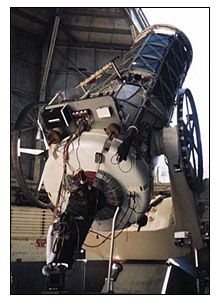HARVARD, Mass., April 12, 2006 -- A new optical telescope at the Oak Ridge Observatory in Harvard yesterday pointed its giant mirror at the sky for the first time, officially starting its sole mission: to search for signs of alien life in the universe.

The new optical SETI at Oak Ridge Observatory. The largest optical telescope east of the Mississippi officially celebrated first light yesterday, marking the beginning of its search for intelligent life in the universe.
Located high on a wooded ridge in Harvard, the building housing the telescope appears from a distance to be a small work shed, but a closer inspection reveals some unusual features, including a retractable roof and a large side window with a sliding screen. The device inside represents one of the most ambitious SETI (search for extraterrestrial intelligence) projects ever undertaken: an optical telescope dedicated exclusively to the search for alien life.
Through a grant from The Planetary Society, Harvard University physicist Paul Horowitz and his team built the brand-new observatory, named in honor of the society. The new 72-in. optical telescope has now begun its year round all-sky survey in search of alien light signals. According to the society's Web site, the new telescope is not only the largest in North America devoted to SETI, it is also the largest optical telescope in the US east of the Mississippi.
The new observatory is one of the largest SETI projects ever sponsored by The Planetary Society, which has supported a variety of different approaches over the years in the search for aliens. The largest of these were radio-based, which require large and expensive facilities compared to smaller and cheaper optical SETI projects. "We have been listening for alien signals for decades," said Louis Friedman, Planetary Society executive director. "It's time we started to watch for signals as well."
The structure and the new telescope have been in place since 2003 and the electronic system and the high-speed processors were installed in 2005 and early 2006. The last component added was the custom-built 150-lb camera, which is able to scan the skies and record even the briefest of light signals, according to the society.
"But in order to start receiving light signals from an alien civilization, two conditions must be met first: they must be pointing their beam directly at us, and we must be looking for it. We cannot say, of course, what the aliens would do, but with the new dedicated optical SETI telescope, we will now be looking," the society said on its Web site.
According to optical SETI advocates, alien civilizations are at least as likely to use visible light signals for communicating as they are to use radio transmissions. Visible light travels easily through space with little interference. A bright, tightly focused light beam, such as a laser, can be 10 times as bright as the sun and be easily observed from enormous distances. Unlike radio waves, laser-like light signals are also unidirectional, making it possible to determine their source with great precision, and because of their higher frequencies, can be used to send vast amounts of information, the society said.
For more information, visit: www.planetary.org